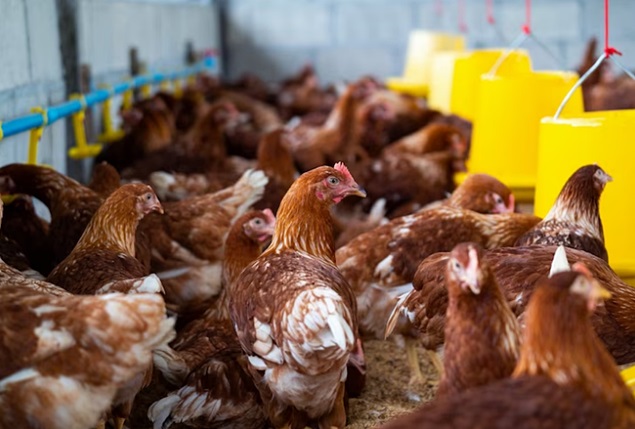
As the effects of climate change become more evident, extreme weather events such as El Niño are impacting various aspects of agriculture, including the stability of animal feed premixes and the nutritional value of poultry diets, according to PoultryWorld.
Mineral traces and nutrient stability
The interaction between weather conditions and the effectiveness of feed ingredients, especially trace minerals, in warm and humid environments is a critical aspect. To address these concerns, PoultryWorld has published a study exploring the importance of selecting a trace mineral with the ability to maintain nutrient stability and enhance poultry performance in challenging weather conditions.
When formulating diets for poultry, several factors must be considered, including the nutritional components needed, ingredient costs and availability, as well as the quality and handling of ingredients. However, less thought is given to how ingredients interact with other components of the diet and the environmental humidity.
Some ingredients, including poor-quality trace minerals, can react with these other dietary components. This reactivity can lead to unwanted interactions with environmental conditions, especially humidity.
Certain trace minerals, such as sulfate mineral traces with an ionic bonding structure, are more reactive to environmental conditions than others. When moisture is present, sulfate mineral traces can dissolve and dissociate, making them reactive to other diet ingredients. Expensive components like vitamins, enzymes, and fats can be affected by this reactivity.
The impact of humidity
A study was conducted to investigate the interaction between trace minerals and dietary vitamins in the presence or absence of humidity. In this study examining the interaction between dietary vitamins and trace minerals, several types of copper trace minerals for use in combination with vitamin A were investigated.
Realistic amounts of copper sulfate (CuSO4), copper hydroxychloride (IntelliBond Copper), and vitamin A were combined with the antioxidant BHT and tested for a reaction both with and without the presence of humidity. The test looked for evidence of vitamin A degradation in the sample.
When copper sulfate was mixed with vitamin A, there was a 25% degradation of vitamin A even when humidity was not present to increase reactivity. However, IntelliBond Copper did not result in a greater reduction in vitamin levels.
There was some degradation when IntelliBond Copper was added, and humidity was present, but there was a more significant loss of vitamin A when copper sulfate was used.
Like vitamins, trace minerals can interact with enzymes added to diets, especially in hot and humid conditions when ambient humidity is present. Enzymes such as phytase are commonly used in poultry feed to improve precision formulation and reduce nutrient waste.
However, if such enzymes react with trace elements in the diet, their effectiveness is reduced. A study comparing copper sulfate to IntelliBond Copper found a 17% increase in phytase activity or phosphorus retention when copper hydroxychloride was used instead of copper sulfate.
Particle size matters
Research has shown that the particle size of trace minerals can play a crucial role in maintaining nutrient stability. Smaller particles of copper sulfate tend to lead to faster nutrient degradation, while larger particles exhibit better stability. In contrast, IntelliBond Copper performs better than copper sulfate, ensuring nutrient retention and stability even in the presence of humidity.
A research study examined how quickly vitamin A degraded when humidity was present and different types of copper trace minerals were used. When copper was not present, the stability of vitamin A decreased slowly—approximately 40% of the vitamin remained on the last day of the test (day 14).
Adding copper sulfate to the mixture had a dramatic response based on particle size, with smaller particles being less stable. Adding copper sulfate with particles of less than 75 µm—the smallest particle size used—resulted in vitamin A stability dropping to nearly 0% on day 12 of the test.
When copper hydroxychloride was added to the mixture, degradation increased slightly, with approximately 38% remaining after 14 days. When copper sulfate was added with particles the same size as IntelliBond Copper, vitamin A stability decreased more rapidly, dropping to around 25% on day 11.
Economics of diet formulation
When considering the economic aspect of diet formulation, the cost of ingredients is a crucial factor. Sulfate-based trace minerals have long been favored for their lower cost compared to alternatives such as hydroxy and organic trace minerals.
However, the potential harm they can cause to other components of the diet and the hidden costs associated with this damage are often overlooked.
In contrast, IntelliBond trace minerals offer a cost-effective and safe alternative that not only ensures better poultry performance but also protects the nutritional integrity of the diet.
Advantages of stability
IntelliBond minerals offer several benefits that make them an attractive choice for poultry diets. These advantages include improved nutrient stability, reduced nutrient degradation, better feed conversion rates, and increased poultry weight gain.
Furthermore, IntelliBond minerals have the ability to ensure that trace minerals do not negatively react with other diet components due to their covalent bonds, making them ideal for use in hot and humid conditions.
As the frequency of extreme weather events increases due to climate change, it is essential to consider the impact of environmental conditions on the stability of poultry diets and nutrient retention. By using IntelliBond minerals with IntelliBond capability, poultry producers can protect their dietary components and optimize feed formulations even in challenging weather conditions.
With improved nutrient stability and enhanced poultry performance, incorporating IntelliBond minerals becomes a smart investment for poultry growers.





